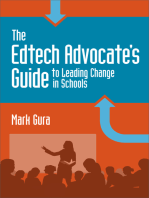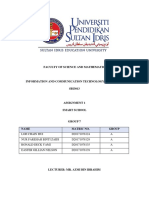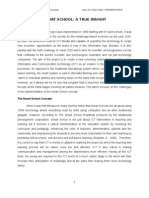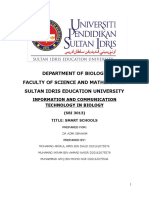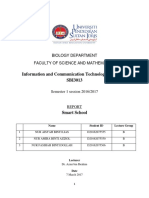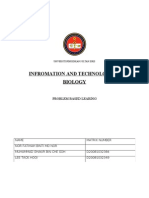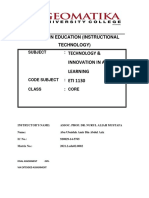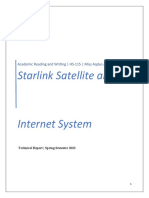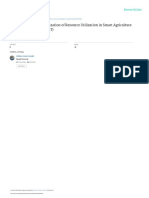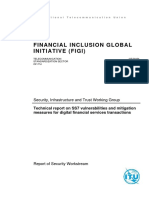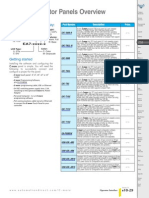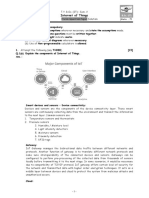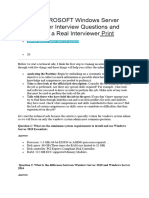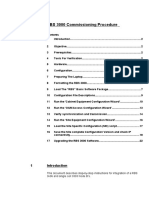0 ratings0% found this document useful (0 votes)
50 views1.) Teaching and Learning Component in Smart Schools 2/) Technology Enablers
1.) Teaching and Learning Component in Smart Schools 2/) Technology Enablers
Uploaded by
Muhammad Afiq1) The document summarizes the key aspects of Smart Schools in Malaysia, including the teaching and learning components and role of technology.
2) Smart Schools aim to prepare students for the digital age by equipping schools with technology for teaching and learning, as well as interconnecting schools through networks.
3) The initiatives of Smart Schools in Malaysia include producing a technology-literate workforce, applying technology in teaching and learning, increasing stakeholder participation, and providing equal access to learning opportunities through technology.
Copyright:
© All Rights Reserved
Available Formats
Download as DOCX, PDF, TXT or read online from Scribd
1.) Teaching and Learning Component in Smart Schools 2/) Technology Enablers
1.) Teaching and Learning Component in Smart Schools 2/) Technology Enablers
Uploaded by
Muhammad Afiq0 ratings0% found this document useful (0 votes)
50 views8 pages1) The document summarizes the key aspects of Smart Schools in Malaysia, including the teaching and learning components and role of technology.
2) Smart Schools aim to prepare students for the digital age by equipping schools with technology for teaching and learning, as well as interconnecting schools through networks.
3) The initiatives of Smart Schools in Malaysia include producing a technology-literate workforce, applying technology in teaching and learning, increasing stakeholder participation, and providing equal access to learning opportunities through technology.
Original Title
smart-schools.docx
Copyright
© © All Rights Reserved
Available Formats
DOCX, PDF, TXT or read online from Scribd
Share this document
Did you find this document useful?
Is this content inappropriate?
1) The document summarizes the key aspects of Smart Schools in Malaysia, including the teaching and learning components and role of technology.
2) Smart Schools aim to prepare students for the digital age by equipping schools with technology for teaching and learning, as well as interconnecting schools through networks.
3) The initiatives of Smart Schools in Malaysia include producing a technology-literate workforce, applying technology in teaching and learning, increasing stakeholder participation, and providing equal access to learning opportunities through technology.
Copyright:
© All Rights Reserved
Available Formats
Download as DOCX, PDF, TXT or read online from Scribd
Download as docx, pdf, or txt
0 ratings0% found this document useful (0 votes)
50 views8 pages1.) Teaching and Learning Component in Smart Schools 2/) Technology Enablers
1.) Teaching and Learning Component in Smart Schools 2/) Technology Enablers
Uploaded by
Muhammad Afiq1) The document summarizes the key aspects of Smart Schools in Malaysia, including the teaching and learning components and role of technology.
2) Smart Schools aim to prepare students for the digital age by equipping schools with technology for teaching and learning, as well as interconnecting schools through networks.
3) The initiatives of Smart Schools in Malaysia include producing a technology-literate workforce, applying technology in teaching and learning, increasing stakeholder participation, and providing equal access to learning opportunities through technology.
Copyright:
© All Rights Reserved
Available Formats
Download as DOCX, PDF, TXT or read online from Scribd
Download as docx, pdf, or txt
You are on page 1of 8
1.
)Teaching and learning component in Smart Schools 2/)Technology enablers
http://www.slideshare.net/Lim1990/smart-school-for-blog?next_slideshow=1
1. DEPARTMENT OF BIOLOGY FACULTY OF SCIENCE & MATHEMATICS SULTAN
IDRIS EDUCATION UNIVERSITY Information And Communication Technology In
Science (SSI 3013) TITLE : REPORT ON SMART SCHOOL PREPARED FOR: ENCIK
AZMI BIN IBRAHIM PREPARED BY:1. VIVIANA VELENTHIA MICHEAL
D201010XXXXX2. DAYANG SUFINAH BINTI DATU TENG D201010XXXXX3. DARVINA
LIM CHOO KHENG D201010XXXXX SEMESTER 1 SESSION 2012/2013 GROUP B 1
2. 2. LIST OF CONTENTS:Cover iList Of Content iiAcknowledgement iiiAbstract iv1.0
Introduction 12. 0 What is Smart School? 13.0 Smart School Initiatives 34.0 Teaching
And Learning Component In Smart Schools 4 4.1 Curriculum 4 4.2 Pedagogy 5 4.3
Assessment 7 4.4 Teaching Learning Materials 85.0 Technology Enablers 96.0
Overview Of The Smart School Progress 10 6.1 Wave 1 The Pilot (1999 - 2002) 11 6.2
Wave 2 The Post-Pilot (2002 2005) 12 6.3 Wave 3 Making All Schools Smart,
MSSS (2005 2010) 13 6.4 Wave 4 Consolidate And Stabilise (2011 2020) 137.0
Challenges Faced Since The Inception Of Smart Schools In Malaysia 148.0 Conclusion
15 2
3. 3. Reference v 3
4. 4. ABSTRACTThis report was written about the Smart School Program that has been
launched by ourgovernment to prepare the future generation to become the competitive
workforce andall-round development individuals. This report actually is based on the
presentation thatwe had prepared as required by our lecturer, Encik Azmi. The
presentation is about theintroduction of Smart School Program to a group of science
teachers from Indonesia bysenior officers from the Ministry Of Education. In this report,
there are some brief introduction about the transformation bring bytechnology to the
globe and Smart School. In the next section of this report, Smart Schoolinitiatives is listed
out and some elaboration on the initiatives. Later, the teaching andlearning component in
Smart Schools that include 4 parts which are curriculum,pedagogy, assessment, and
teaching and learning materials. After that, the use of technology as enablers contained
in Smart School concept isalso listed out. The overview of the Smart Schools progress
also included in this report.There are 4 waves in the progress of Smart School program
which are The Pilot, ThePost-Pilot, Making All Schools Smart (MASS) and Consolidate
And Stabilise. Lat but not least, the challenges that faced by the Smart School since its
inceptionalso listed out in this report, follows up by the conclusion part. 4
5. 5. ACKNOWLEDGMENTWe would like to thanks our lecturer, En. Azmi Ibrahim for his
valuable advices that hegave during the process of preparing the report that titled Report
On Smart School andthe presentation on Smart Schools. The advices truly help us a lot
in the preparationprocess of this report and the presentation. Besides that, we would also
like to show our appreciation to our classmates thatgave suggestions during the process
of preparing this report and presentation. Next, wewould also like to thanks our friends
that share their ideas, thoughts and give suggestionsto us. In conclusion, we would like to
thanks to everyone that involve directly orindirectly in the process of preparing this report
and presentation. 5
6. 6. 1.0 INTRODUCTIONThe world we live in today is currently undergoing a massive
transformation as a resultof the digital revolution. The transformation also has been
greatly affecting the world ofeducation. Education is a very important part of a country as
it has the duty to educateyoung people who are responsible for the country s future
development and progress.Therefore, in our country, with the presence of information
technologies today, ourMalaysian government is also putting huge efforts into education
sector to obtain thegood advantages from it. Smart schools were introduced, students
were encouraged to useinformation and communication technology (ICT), and almost all
schools are equippedwith computers and internet access even in the rural area. The
integration of ICT in smart school does not just only give the benefit of ICTduring
teaching and learning process. This new technologies have created learningopportunities
that challenges traditional schools and colleges. Furthermore, they enablepeople of all
ages to pursue learning on their own terms. Smart schools in Malaysia haveshown a
good progress since its establishment. Although there are several challenges andissues
faced, the smart schools in Malaysia were constantly being monitored andupgraded to
match the current conditions and the education needs.2.0 WHAT IS SMART SCHOOL?In
Malaysia, smart schools are learning institutions that are reconstructed to fit theglobally
evolving world of information and technology. These learning institutions aredesigned in
terms of teaching and learning practice and school management in order toprepare
children for the life in this Information Age. In this age, the development of ICTwitnessed
to be occurring fast. Therefore, to adapt with this ever changing condition,smart school
will evolve over time, continuously developing and advancing itsprofessional staffs, it s
educational resources and its administrative capabilities. Based on the purpose of smart
school to prepare children for the Information Age,smart school is provided with all the
technology needed extending from the school level 6
7. 7. up to national level. Smart school is equipped with technology that can facilitate
teachingand learning process such as multimedia, and assists the school management;
databaseapplication for instance. These are among the technology that provided in smart
school:School level technology:Facility DescriptionClassrooms Equipped with multimedia
courseware and presentation facilities, and e-mail or groupware for collaborative
work.Library/Media Centre With database centre for multimedia courseware, and network
resources like access to the internet.Computer laboratory For teaching, such as
Computer Studies as a subject, and readily accessible multimedia and audiovisual
equipment.Multimedia With tools for creating multimedia materials and catering
toDevelopment Centre varying levels of sophistication.Studio/Theatre With a control room
for centralized audiovisual equipment, video conferencing studio, preview room for audio,
video, or laser disc materials.Teachers Room With on-line access to courseware
catalogues and databases, information and resource management systems, professional
networking tools, such as e-mail and groupware.Administration Offices Capable of
managing databases of student and facilities, tracking student and teacher performance
or resources, and distributing notices and other information electronically.Server Room
Equipped to handle applications, management databases, and web servers; provide
security; and telecommunications interface and access to network resources. Table:
Technological facility in smart school (Source: Smart school conceptual blueprint) Smart
school is not about the technology around the school only. It is also aboutthe technology
that interconnecting the smart schools and educational technology in 7
8. 8. district and national level. The network is maintained secured for the
communicationbetween schools and the national authorities. Districts will also need to
maintainextensive databases for information like assessment records of student and
teacherperformance; human resource records; matters of governance, financing, and
security;and educational resources.3.0 SMART SCHOOL INITIATIVESSmart school was
initiated in Malaysia more than 15 years ago as the technological erawave also hit the
country. In order to keep up with the changing world of technology,there is a need to start
educating the young one with technology and with more holisticeducation. There are
several main initiatives of smart school. Firstly, smart school was introduced in the
initiative to produce a thinkingtechnology-literate work force. Most of the jobs nowadays
demand for skilled workersespecially in dealing with the technology. Therefore, smart
school will have theresponsibility to educate and prepare students for their real life after
school. In smartschool, students will be taught of thinking across the curriculum. Outside
the classroomand out of the school syllabus, students still can search for information for
their ownknowledge. Other than that, technology is also applied in teaching and learning
process insmart school. Thus, students will get used to the technology-environment to
learn or workwith. Moreover, the technology in smart school will increase the participation
ofstakeholders. Technology enables easy and speedy communication of stakeholders
withthe school. This condition will create the awareness of what had happens in
schools.Therefore, indirectly technology can provide the opportunities for stakeholders,
forexample parents community to participate in the school programs. Smart school also
democratizes education by providing equal access to learningopportunities. In smart
school, everyone can have the access to the technology or internet.We all know that
technology has transformed our larger society. It has become central topeople s reading,
writing, calculating, and thinking. With technology, learning can be 8
9. 9. done at anytime, and in every way desired. Therefore, smart school and technology
alsoprovided for differing abilities, styles and paces of learning. Just like any other school,
smart school also developed to provide all-rounddevelopment of the individual. This
covers the development of intellectual, physical,emotional, and spiritual. Smart school
provides a broad curriculum for all, teach valuesand language across the curriculum, and
emphasize thinking skills.4.0 TEACHING AND LEARNING COMPONENT IN SMART
SCHOOLSThe teaching and learning component comprises four areas: 1. Curriculum:
designed to help students achieve overall and balanced development. 2. Pedagogy:
allows for appropriate mix of learning strategies to ensure mastery of basic competencies
and promotion of holistic development. 3. Assessment: designed to give accurate
feedback of students readiness, progress, achievement and aptitude. 4. Teaching and
learning materials: cognitively challenging and motivating by combining the best of
network based, teacher-based, and courseware materials.4.1 CURRICULUMThe smart
school curriculum shall be meaningful, social responsible, multicultural,reflective, holistic,
global, open-ended, goal-based and technological. It shall promoteholistic learning,
allowing children to progress at their own pace, and catering forstudents varying
capabilities, interest and needs. It will seek to ensure that children areeducated with
critical and creative thinking skills, inculcated with appropriate values, andencouraged to
improve their own language proficiency. New elements that found inSmart School
curriculum are purposed on all-round development of students appropriatefor this era.
Thus, the curriculum will be designed to: 9
10. 10. 1. Help students achieve overall balanced development integrate knowledge, skills,
values, and correct use of language. Domain All round development Effective oral and
written communication in Malay. Communication English as a second language.
Emphasis multiple languages, interpersonal skills and networking. Focus on acquiring
knowledge. Focus on searching, Cognitive generating, and using knowledge with an
emphasis on problem-solving and creativity. Instill moral and religious values. Emphasis
adaptability, Affective team player characteristics, emotional balance and emotional
intelligence. Physical Instill social responsibility and consciousness of health and
environmental issues. Emphasis a global orientation and inculcate work place skills and
attitudes. (Source: Smart school conceptual blueprint)2. State explicitly intended learning
outcomes for different ability levels.3. Foster the knowledge, skills, and attitudes
appropriate for success in the Information Age.4. Offer multidisciplinary, thematic, and
continuous learning.4.2 PEDAGOGYThe smart school pedagogy will seek to make
learning more interesting, motivating,stimulating and meaningful. This component
involves the children minds, spirit, andbodies in the learning process. It also builds basics
skill to prepare children for greaterchallenges over time and cater for a range of needs
and capabilities among the students.The pedagogy shall: 10
11. 11. 1. Use an appropriate mix of learning strategies to ensure mastery of basic
competencies and promote holistic development. Involves specific learning goals Process
Active learning process, where learner constructs meaning - Continuous - Personalized
Alone, in pairs, or in small teams with an expert (teacher or community member), a
facilitator (teacher assistant, volunteer or Modes student), non-human resources (hands-
on materials, computer- based resources, multimedia resources, or print materials) At a
site in the community, a computer-based multimedia simulation, a hands-on learning lab,
a meeting room or library. Authentic, often in real life environments, with real world
challenges interdisciplinary: - Specific knowledge Tasks - General skills such as transfer
of information across settings, negotiation and interpersonal skills, decision making skills
Mastery of a task before progressing to next task Periodic performance mastery
assessment More responsibility to learner for directing and managing own learning.
(Source: Smart school conceptual blueprint)2. Accommodate individual different learning
styles, so as to boost performance. Differentiating Teacher- Teacher as Teacher as
Student- Factors centred mentor and coach or centred model Facilitator Establishment
Established Established Established Established 11
12. 12. of learning by Teacher by Teacher through by student objectives discussion with
teachers between suggestion student and and input teacher Determination Determined
Suggested by Determined Determined of instructional by Teacher teacher, open by
student by student tasks to discussion with teacher s with teachers suggestion
suggestion and input and input Selection of Selected by Suggested by Selected by
Selected by Resources for Teacher teacher, open student with student with tasks to
discussion teachers teachers suggestion suggestion (Source: Smart school conceptual
blueprint)3. Faster a classroom atmosphere that is compatible with different teaching-
learning strategies. Creating an atmosphere of respect and rapport Establishing a
culture for learning Managing classroom procedures Managing student behavior
Organizing physical space4.3 ASSESSMENTThe smart school assessment system will
be distinctly different from current system tohelp realize the National Philosophy of
Education. It shall be element-based andcriterion-referenced to provide more holistic and
accurate picture of studentsperformance. Teachers, students, and parents will be able to
access on-line assessmentitems. Smart school assessment will be flexible and learner-
friendly, while assuring the 12
13. 13. quality of the assessment information by using multiple approaches and instruments.
Itwill lead to living certification, which not only attest to a students
cumulativeaccomplishments but will also be open to continued improvement on a lifetime
basis. Thescope of assessment in the Smart School is holistic and gives various
informationregarding the students learning styles and abilities such as: Learners have
different experiences and their levels of entry in certain Readiness learning areas need to
be assessed. The students progress in achieving certain learning objectives needs to be
Progress monitored. His/her strengths and weaknesses also need to be diagnosed.
Assessing the achievement of each intended learning outcome in a learning Achievement
area is necessary to indicate whether the learner is ready to move on to the next area.
Learners different styles of learning and multiple intelligences have to be Aptitude
recognized.4.4 TEACHING-LEARNING MATERIALSSmart school will need teaching-
learning materials designed for the new strategies. Thesematerials will accommodate
students differing needs and abilities, resulting in furtherrealization of their capabilities
and potential, and allow students to take greaterresponsibility for managing and directing
their own learning. The materials should becognitively challenging, attractive, motivates
students to learn and encourages activeparticipation. In addition, the materials will be
acquired from a wide range of sources. 13
14. 14. Conceptual selection and evaluation guidelines for teaching-learning materials will
cover5 main criteria: Cosmetic Adequacy Instruction Adequate Curriculum Adequate
Graphic quality Promotes vertical and In-line with curriculum Video quality horizontal
integration specifications Animation quality Consider different Promotes Voice and
sound quality capabilities of students values, skills, knowledge, and teachers and
language across the Layout quality Suitable for a variety of curriculum Color and
fonts quality learning environment Consistent with teaching- Well designed interface
learning objectives Professionally done Content is accurate and Adaptable to
different up-to-date teaching and learning Content is relevant to styles student s
environment Assessment is built-in Technical Adequate Cost effectiveness User-
friendly Value for money Clear and comprehensive manual guides5.0 TECHNOLOGY
ENABLERSTechnology alone will not make a school smart. Only improved teaching-
learningstrategies, management and administrative processes, and capable, well trained
peoplewith enthusiasm for their work can do that. However, information technology can
enablethe process of transforming traditional school into Smart School. Consequently, a
nation-wide system of Smart Schools will depend on advanced information technology at
theschool, district, state and national levels. The technology has implications on teaching-
learning process, smart school management system and linkages to
externalconstituencies due to smart school practices. 14
15. 15. School-level technology:Technology has many roles to play in Smart School, from
facilitating teaching andlearning activities to assisting with school to assisting with school
might include thefollowing: 1. Classrooms with multimedia courseware, and presentation
facilities, and e-mail or groupware for collaborative work. 2. Library/media centre with
database centre for multimedia courseware, and network resources like access to the
internet. 3. Computer laboratory for teaching, such as Computer Studies as a subject,
and readily accessible multimedia and audiovisual equipment. 4. Multimedia
Development Centre with tools for creating multimedia materials and catering to varying
levels of sophistication. 5. Studio/Theatrette with a control room for centralized
audiovisual equipment, video conferencing studio, professional networking tools, such as
e-mail and groupware. 6. Administration Offices capable of managing database of
students and facilities, tracking students and teachers performance or resources, and
distributing notices and other information electronically. 7. Server Room equipped to
handle applications, management databases, and web servers to provide security and
telecommunications interface and access to network resources.6.0 OVERVIEW OF THE
SMART SCHOOL PROGRESSThe Smart School Flagship is one of the seven flagships
of the Multimedia SuperCorridor (MSC) that has been carried out in the year 2000. The
Smart Schools concepthas began with the launched of The Pilot Project to seek for the
proof-of-concept beforethe next steps or phases are implemented by the government. If
the concept solutionfulfills the scope of the service required, then the entire project will be
launched. Phasesin the Smart School Flagship are carried out in 4 waves as below: 15
16. 16. 6.1 WAVE 1 THE PILOT (1999 2002)In this wave, Ministry Of Education (MoE),
Multimedia Development Corporation(MDC) and Telekom Smart School Sdn. Bhd. (TSS)
has build a partnership in order toensure the involvement from both the central and state
levels. The MoE and TSS havesigned the agreement on 28 July 1999. Different parties
play different significant rolessuch as the MoE provided the educational expertise while
the industry partner, TSS onthe other hand was setting up the infrastructure and
developing applications and teaching-learning solutions to fulfill the requirements and
objectives of the Smart School. Besidesthat, MDC was strategic the position and role in
the Information and Communication InTechnology (ICT) growth and development process
of the Multimedia Super Corridor(MSC) for build up the partnerships with the industry
sector. The Conceptual Blueprint of Smart School has clearly stated that two type
ofphases will be launched, which are a Pilot Project phase and a broad roll-out phase
duringthe implementation of the Smart School. Eighty-eight (88) Pilot schools that
recognizedto be the center for the roll-out of Smart School concepts, materials, skills
andtechnologies were participated in this Pilot Project phase. All these selected schools
needto tested 3 models of technology which are a computer laboratory (Level B) (80
schoolsparticipated), a limited classroom model (Level B+) (2 schools participated) and a
fullclassroom model (Level A) (6 schools participated). 16
17. 17. The Pilot Project tested the Smart School Integrated Solution (SSIS) throughvarious
components. At this stage, measures such as teachers and principals trained in useof
Smart School application, ICT infrastructure and systems as an enabler for
qualityteaching and learning, Data Centre, Help Desk and Call Centre are taken.
Theimplementation phase from year 1999 to 2002 was closely monitored by the three
parties.Issues that occurred at this phase were resolved at the meetings that attended by
the threeparties.6.2 WAVE 2 THE POST-PILOT (2002 2005)When the Pilot Project
was successfully concluded in 2002, a consortium of evaluatorsmade up of experts from
the local universities was commissioned by the MoE or MDCpartners to conduct an
evaluation of the project. Others also included a benchmarking study by Frost and
Sullivan, an independentconsultant, to compare the Malaysia Smart Schools Integrated
Solution (SSIS) with eightother countries, a study by local academics, and technology
evaluation by the SmartSchool team and TSS. The benchmarking study compared the
merits of the SSIS and itscomponents with similar implementations in Australia, Britain,
Canada, Ireland, Japan,New Zealand, Singapore and the USA to benchmark their best
practices in ICT-mediatededucation with that of Malaysia. The benchmark shown that
Malaysias achievement isgood as the teaching-learning courseware was tailor-made for
Malaysian curriculumwhile the other countries used courseware developed for the
generic market. The evaluation work began in April 2003 and a report of the findings
waspublished in year 2004. At this stage, it is more to enhancement of 88 Smart Schools.
At Post Pilot phase, massive computerization phase is launched to all 10,000schools.
Infrastructure and measures such as computer lab, SchoolNet, coursewares, e-material
and the Teaching-Learning Science And Mathematics In English (PPSMI), aneducation
policy is conducted to the whole Malaysias schools. 17
18. 18. 6.3 WAVE 3 MAKING ALL SCHOOLS SMART, MASS (2005 2010)Making All
Schools Smart is a continuous process to acculturate the use of technology ineducation
to ensure quality teaching and learning, effectiveness of school administrationand
management and teachers ICT competency. At this wave, the steps of leveraging allICT
initiatives are taken. For examples, EduWebTV and School Access Centre are set upand
made full use of them.Smart School Qualification Standards (SSQS), a monitoring tool is
used to measure theutilization of ICT in schools. This SSQS focusing on 4 domains,
which are 40% onhuman capital, 40% on utilization, 10% on application and another 10%
on infrastructure.SSQS Star Ratings for the schools divided into 5 categories which the
best is AdvancedPlus (5*), follow up by Advanced (4*), Median (3*), Basic Plus (2*) and
lastly Basic(1*). In 2010, MoE has awarded Smart School rating to 8147 schools. This
means theyhave achieved at least three stars. About 88.9% of schools have achieved
smart schoolstatus in the end of this wave.6.4 WAVE 4 CONSOLIDATE AND
STABILISE (2011 2020)At this wave, continuous effort is continued. Meticulous
planning and monitoring,rigorous training and upgrading of teachers and school
administrators, enhancement ofinformation literary among school leavers and formulation
of smart partnerships aretaken to consolidate and sustain the Smart Schools progress.
The Educational Technology Division, as the lead agency in the MoE Malaysiahas
prepared the Smart School Strategic Plan, 2011-2015 (Pelan Strategik
Pembestarian2011-2015) to achieved the objectives of MASS. National Key Results
Areas (NKRA)for education that emphasis the need for improving students outcomes
and providingaccess to quality education for all is launched. All the 10,000 schools
should achieve the smart schools standards in this wave.One of MoEs strategies to
ensure schools achieve the Smart School status is by means ofthe Catalyst Schools
programme. This strategy is expected to generate the Mutiplier 18
19. 19. Effect to speed up the process of achieving the 5 star ranking by other schools. The
5star SSQS catalyst schools are required to mentor, guide and hand-hold schools
withintheir group and walk them through the MASS process. Catalyst School System To
make sure the Catalyst School Program succeed, several programmes wereimplemented
like mindset & culture change, sharing of best practices, CommunityProgrammes/Smart
Partnerships, ICT Buddy Support, Bestari Club (Bestari Brigade) andOn-Site
Monitoring.7.0 CHALLENGES FACED SINCE THE INCEPTION OF SMART SCHOOLS
IN MALAYSIASince the inception of Smart Schools in Malaysia, numerous of challenges
have to befaced in the process of ensuring the successful of this project. First of all,
continuousmonitoring and coaching of innovative use of technology in schools need a lot
of effort 19
20. 20. and determinant from the responsible parties. Without the continuous monitoring
andcoaching, the Smart Schools implementation would not be success as now.
Secondly, continuous upgrading of infrastructure such as the broadband andhardware
need to be concern and take action. Since the technology and information of theworld is
upgrading and increase from time to time, MoE, MDC and TSS must cooperatemore to
fulfill the need of the Smart Schools from the aspect of latest infrastructure. Inaddition,
instilling the ownership of Smart School initiatives among the stakeholders andchanging
the mindset of teachers and stakeholders also are the challenges need to befaced. By
overcome this challenge, the Vision 2020 can be better achieved through SmartSchools
Project as the stakeholder feel that they have the responsibility andaccountability to make
it a reality. Thirdly, alignment of objectives at all levels required, within the Ministry
andbetween Ministries or agencies. Without the alignment of objectives, the inception
andcontinuous effort for Smart Schools will totally be a mess and waste of time and
energy.With the alignment, the human resources, money, plans and other will be
effectively usedto achieve the best and maximum success.8.0 CONCLUSIONIn
conclusion, the inception of Smart School in Malaysia is a big leap in our localeducation
to achieve our nation Vision 2020. The continuous effort towards making it s abig
success requires fully involvement of all the stakeholders. There still have challengesand
obstacles need to face and overcome by all the stakeholders. However, cooperationand
ownership of Smart School from the stakeholder can overcome the challengeseffectively.
20
21. 21. REFERENCESAge of Information and Technology (2008). Retrieved on October 14,
2012 from http://www.studymode.com/essays/Age-Information-Technology-
181936.htmlAllan Collins, Richards Haverson(2012). Rethinking Education in the Age of
Technology: The Digital Revolution and the Schools. Retrieved on October 14, 2012 form
http://llk.media.mit.edu/courses/readings/Collins-Rethinking- .pdf.Azian T.S Abdullah
(2006, December). The Malaysian Smart School Initiative. Digital Learning. Volume ll
Issue 12. 6-9. Retrieved Oktober 11, 2012 from
http://asianvu.com/bookstoread/framework/dl_page14_badrulKhan_dec06.pdfEducationa
l Technology Division (2011). Hearts And Minds Towards Making All Schools Smart.
Retrieved Oktober 10, 2011 from http://www.slideshare.net/F adzliaton/hearts-and-minds-
towards-making-all-schools-smart.Malaysian Smart School (2008). Retrieved October 8,
2012 from http://www.mscm.m y/topic/About+Smart+School.Siti Zaleha Binti Abdullah
Sani (2011). Making Schools Smart: The Malaysian Experience. Retrieved October 11,
2012 from http://asli.com.my/DOCUMEN TS/15MsiaEdu/10.%20Dr%20Dorothy.pdf. 21
22. 22. The Malaysian Smart School An MSC Flagship Application-A Conceptual Blueprint
(1997). Retrieved October 11, 2012 from http://www.mscmalaysia .my/sites/default
/files/pdf/publications_references/Smart_School_Blueprint. pdf.The Smart School
Roadmap 2005-2020: An Educational Odyssey (2005). Retrieved October 10, 2012 from
http://www.slideshare.net/mariating/smart-school- roadmap. 22
You might also like
- Digital Society Sylabus GuideDocument55 pagesDigital Society Sylabus GuideRajat PalaswadikarNo ratings yet
- Real Smart School PDFDocument11 pagesReal Smart School PDFNur FarehahNo ratings yet
- OSI ModelDocument32 pagesOSI ModelBhanu Singh0% (1)
- Ict Assignment 1Document11 pagesIct Assignment 1anis hauraNo ratings yet
- Report: Smart SchoolDocument10 pagesReport: Smart SchoolaimiNo ratings yet
- Introduction SSI Smart SchoolDocument10 pagesIntroduction SSI Smart SchoolNorain Hanani OmarNo ratings yet
- Report For Smart SchoolDocument9 pagesReport For Smart SchoolnorsyafiqamohamadNo ratings yet
- Information and Communication Technology in ScienceDocument10 pagesInformation and Communication Technology in Sciencenurul husnaNo ratings yet
- Challenges in Implementation of Smart School in MalaysiaDocument10 pagesChallenges in Implementation of Smart School in Malaysiarosfarhana roziNo ratings yet
- Ssi3013-Information and Communication of Technology in ScienceDocument10 pagesSsi3013-Information and Communication of Technology in SciencesyazanaNo ratings yet
- Introduction Smart SchoolDocument11 pagesIntroduction Smart SchoolNurshahirah ZulkipliNo ratings yet
- Smart School and Its ChallengesDocument10 pagesSmart School and Its ChallengesMUHD MUHAIAMIN BIN ROSLANNo ratings yet
- Smart School: A True InsightDocument7 pagesSmart School: A True InsightNoorAiniAbdulMajidNo ratings yet
- Department of Biology Faculty of Science and Mathematics Sultan Idris Education UniversityDocument13 pagesDepartment of Biology Faculty of Science and Mathematics Sultan Idris Education UniversityMuhamad IkramNo ratings yet
- Smart School ProjectDocument10 pagesSmart School ProjectXuan ChuaNo ratings yet
- Information and Communication Technology in Science SSI3013: An Overview of Smart SchoolDocument7 pagesInformation and Communication Technology in Science SSI3013: An Overview of Smart Schoolnor asmimie norliNo ratings yet
- Smart School EssaysDocument10 pagesSmart School EssaysAfifa KhalidNo ratings yet
- Smart School Challenge in MalaysiaDocument9 pagesSmart School Challenge in MalaysiaSiti Nurhaliza Binti JohariNo ratings yet
- Assignment 1: Smart School ReportDocument10 pagesAssignment 1: Smart School ReportSHAFIQAH HANAFINo ratings yet
- Report Smart SchoolDocument15 pagesReport Smart SchoolAnonymous gtDv4Bd0KNo ratings yet
- Universiti Pendidikan Sultan Idris SSI3013 - Information and Communication Technology in ScienceDocument9 pagesUniversiti Pendidikan Sultan Idris SSI3013 - Information and Communication Technology in ScienceAinatul AmiraNo ratings yet
- Infromation and Technology in Biology: Problem Based LearingDocument6 pagesInfromation and Technology in Biology: Problem Based LearingstanleyleeNo ratings yet
- Challenge of Building Smart SchoolDocument10 pagesChallenge of Building Smart SchoolAoi SayuriNo ratings yet
- Impact of Information Technology On Higher Education in Pakistan (A Study On People of Faisalabad, Pakistan)Document10 pagesImpact of Information Technology On Higher Education in Pakistan (A Study On People of Faisalabad, Pakistan)inventionjournalsNo ratings yet
- Assignment 1 - Challenging Smart SchoolDocument7 pagesAssignment 1 - Challenging Smart SchoolNur ShahidaNo ratings yet
- Alex Maitaria 6TH Aoril 2023Document18 pagesAlex Maitaria 6TH Aoril 2023Kiptanui AlecNo ratings yet
- ICT in Malaysian Schools Policy and StrategiesDocument6 pagesICT in Malaysian Schools Policy and StrategiesMisfit XavierNo ratings yet
- Midterm Examination - 2nd Sem 2022-2023Document4 pagesMidterm Examination - 2nd Sem 2022-2023Jennifer GacadNo ratings yet
- Challenge of Smart School in MalaysiaDocument11 pagesChallenge of Smart School in Malaysiadiela9026100% (1)
- Smart School ReportDocument10 pagesSmart School ReportikhmalNo ratings yet
- Assignment The Role of Information Technology Centres in Improving EducationDocument4 pagesAssignment The Role of Information Technology Centres in Improving EducationwaseemNo ratings yet
- FINAL ASSESSMENT ETI1130 Abu Ubaidah Amir Bin Abdul Aziz (2021.2.edu02.0002) 0187029086Document11 pagesFINAL ASSESSMENT ETI1130 Abu Ubaidah Amir Bin Abdul Aziz (2021.2.edu02.0002) 0187029086Abu UbaidahNo ratings yet
- Educational Technology 2Document38 pagesEducational Technology 2Chrisshalyn Sy Pineda60% (5)
- St. John College of Engineering and Management (Formerly St. John College of Engineering and Technology)Document32 pagesSt. John College of Engineering and Management (Formerly St. John College of Engineering and Technology)Dr. Eknath PatilNo ratings yet
- Smart SchoolDocument10 pagesSmart SchoolNurul natihah100% (1)
- Challenges of Smart SchoolDocument12 pagesChallenges of Smart SchoolNazura Yusof100% (5)
- DR TunjiDocument4 pagesDR Tunjifaith essienNo ratings yet
- "Malaysian Smart School": Information and Communication Technology in Science Ssi3013Document12 pages"Malaysian Smart School": Information and Communication Technology in Science Ssi3013tracyNo ratings yet
- Technology For Teachinng and Learning 2Document39 pagesTechnology For Teachinng and Learning 2LAMPAS, John Lloyd L.No ratings yet
- Mini Project UPGraded NewDocument34 pagesMini Project UPGraded NewairmanchulbulpandeyNo ratings yet
- Educational Technology 2Document38 pagesEducational Technology 2Chrisshalyn Sy Pineda100% (1)
- Thesis Ict in EducationDocument7 pagesThesis Ict in EducationMary Calkins100% (2)
- Northumberland Ict Vision FinalDocument12 pagesNorthumberland Ict Vision FinalfranklinNo ratings yet
- Smart SchoolDocument9 pagesSmart SchoolWan Syafika NabilaNo ratings yet
- New Synopsis JagdeepDocument21 pagesNew Synopsis Jagdeepharjot100% (1)
- Role of ICT in Education 8pDocument9 pagesRole of ICT in Education 8pImane BourafaNo ratings yet
- Smart SchoolDocument10 pagesSmart SchoolShazrizal ShahmyNo ratings yet
- ICT InfDocument3 pagesICT Infnani66215487No ratings yet
- Technology For Teachinng and Learning 2Document39 pagesTechnology For Teachinng and Learning 2Alex Sanchez0% (1)
- The Importance of Ict in Classroom TeachingDocument3 pagesThe Importance of Ict in Classroom TeachingDamon Joseph Anson77% (13)
- Handout For TTLDocument12 pagesHandout For TTLMarites OrtegaNo ratings yet
- Malayasia Smart SchoolDocument5 pagesMalayasia Smart SchoolGee AgomNo ratings yet
- Angelyn Leguarda2Document22 pagesAngelyn Leguarda2api-267029466No ratings yet
- What Is A Smart SchoolDocument11 pagesWhat Is A Smart Schoolsaye cantik86% (7)
- Role of ICT in Teaching Learning ProcessDocument6 pagesRole of ICT in Teaching Learning Processsimpleton cruseNo ratings yet
- Asia Pacific Region Educational TechnologyDocument3 pagesAsia Pacific Region Educational Technologyemil_masagca1467No ratings yet
- Information and Communication Technology in Biology: Lect. Name: Dr. Azmi Bin IbrahimDocument10 pagesInformation and Communication Technology in Biology: Lect. Name: Dr. Azmi Bin IbrahimAjip UzaimiNo ratings yet
- Educational Technology 2 (MSC 2-05)Document23 pagesEducational Technology 2 (MSC 2-05)Jonel Pagalilauan50% (4)
- Teaching and Learning in Technology Empowered Classrooms—Issues, Contexts and PracticesFrom EverandTeaching and Learning in Technology Empowered Classrooms—Issues, Contexts and PracticesNo ratings yet
- Efficacious Technology Management: A Guide for School LeadersFrom EverandEfficacious Technology Management: A Guide for School LeadersNo ratings yet
- Set Up An iSCSI Server in RHEL 6.xDocument6 pagesSet Up An iSCSI Server in RHEL 6.xPrabir MeherNo ratings yet
- Installing and Configuring Windows Server 2012: Official Microsoft Learning ProductDocument406 pagesInstalling and Configuring Windows Server 2012: Official Microsoft Learning ProductEduardo PlNo ratings yet
- Lotus CcMail and Exchange 2000 Server Coexistence and MigrationDocument97 pagesLotus CcMail and Exchange 2000 Server Coexistence and MigrationsenhydNo ratings yet
- Star LinkDocument12 pagesStar LinkHuzaif samiNo ratings yet
- IEEEIoTJournal-A Novel Model For Optimization of Resource Utilization in Smart Agriculture System Using IoT SMAIoTDocument9 pagesIEEEIoTJournal-A Novel Model For Optimization of Resource Utilization in Smart Agriculture System Using IoT SMAIoTNiteeshkumar HVNo ratings yet
- Technical Report On SS7 Vulnerabilities and Mitigation Measures For Digital Financial Services TransactionsDocument38 pagesTechnical Report On SS7 Vulnerabilities and Mitigation Measures For Digital Financial Services TransactionsАндрей АлемасцевNo ratings yet
- Certificate IV in Information Technology (Networking) : DetailsDocument4 pagesCertificate IV in Information Technology (Networking) : Detailsbhavinshah23No ratings yet
- HC110110002 Ethernet FramingDocument20 pagesHC110110002 Ethernet FramingjscansinoNo ratings yet
- A Detailed Lesson Plan in TLE ICT 6 PDFDocument14 pagesA Detailed Lesson Plan in TLE ICT 6 PDFRojel Jan GalzoteNo ratings yet
- Apparent ReportDocument42 pagesApparent Reporthabtamu tadleNo ratings yet
- Ea7 Cmore HmiDocument16 pagesEa7 Cmore HmiJesus GarciaNo ratings yet
- IT Infrastructure Audit ScopeDocument2 pagesIT Infrastructure Audit Scopeegidiah15No ratings yet
- Avaya Scopia Video Conference Ritso Users TrainingDocument91 pagesAvaya Scopia Video Conference Ritso Users TrainingJed MalabananNo ratings yet
- DS-7600NI-I2/P Series NVR: Key FeatureDocument5 pagesDS-7600NI-I2/P Series NVR: Key FeatureFabian BonillaNo ratings yet
- MidsolDocument10 pagesMidsolAmeer El-SayedNo ratings yet
- Product Manual 26518V3 (Revision C) : Micronet TMR 5009Ft Fault-Tolerant Steam Turbine ControlDocument240 pagesProduct Manual 26518V3 (Revision C) : Micronet TMR 5009Ft Fault-Tolerant Steam Turbine Controlkazmi81100% (1)
- Obix CD02 19017readDocument62 pagesObix CD02 19017readMark Izsm AmersonNo ratings yet
- CN Unit-1 PPTDocument230 pagesCN Unit-1 PPTFjjdjrj djrjfjNo ratings yet
- Fiber 101: Best Practices in Fiber Design and Deployment For MdusDocument19 pagesFiber 101: Best Practices in Fiber Design and Deployment For MdusS M HADIUZZAMANNo ratings yet
- Ncipher Nforce v2 12-02-200 PDFDocument2 pagesNcipher Nforce v2 12-02-200 PDFMyOwnScribdAccountNo ratings yet
- Internet of Things: Time: 2 HRS.) (Marks: 75Document25 pagesInternet of Things: Time: 2 HRS.) (Marks: 75shweta vermaNo ratings yet
- MLK-II Hard WareDocument136 pagesMLK-II Hard Wareashishcnair100% (1)
- HDI Hardware Components v1-0Document39 pagesHDI Hardware Components v1-0fqchinaNo ratings yet
- 39 Top MICROSOFT Windows Server Administrator Interview Questions and Answers by A Real InterviewerDocument8 pages39 Top MICROSOFT Windows Server Administrator Interview Questions and Answers by A Real InterviewerNataraju ChNo ratings yet
- RBS 3000 Commissioning ProcedureDocument26 pagesRBS 3000 Commissioning ProcedureEhtesham KhanNo ratings yet
- Setup or Reconfigure EW-7438RPn Series N300 WiFi Extender - EDiMAXDocument1 pageSetup or Reconfigure EW-7438RPn Series N300 WiFi Extender - EDiMAXRaja Pathamuthu.GNo ratings yet
- Captura de Pantalla 2023-07-22 A La(s) 10.45.30 A.M.Document89 pagesCaptura de Pantalla 2023-07-22 A La(s) 10.45.30 A.M.Feer Solano FloresNo ratings yet
- BRKSEC-2024 Design and Deployment of SourceFire NGIPS and NGFWLDocument50 pagesBRKSEC-2024 Design and Deployment of SourceFire NGIPS and NGFWLDavyAvicenneNo ratings yet
